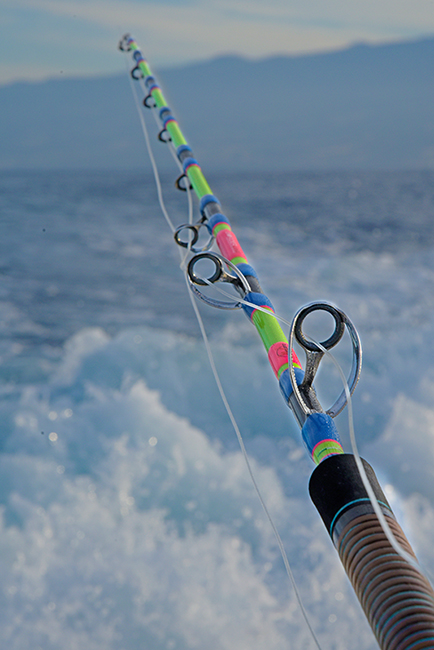SOLID - FULL POWER BLANKS
The SOLID blanks are made of 100% unidirectional 40T carbon, with special latest generation resins with high temperature controlled catalysis (> 180° C). These blanks are obtained through a particular "pultrusion" process followed by a mechanical processing in a numerical control work center. The result is therefore a blank in full carbon, with unique features and
finishes that cannot be seen with the tubular processes: very high reactivity and mechanical properties of elastic response, low taper, very low thickness and therefore limited weight.
ANIMA (SOUL) - SOLID COMPOSITE
Thanks to a particular and exclusive production process a raw blanks is made on a mold of unidirectional 40T solid carbon, the soul indeed! This work is a SOLID action blank with unique and incredible mechanical characteristics. In the common tubular blanks, the tip section is made with high percentage of glass fiber in order to obtain the necessary elasticity. In the case of "Anima", the particular properties of the 40T material allow to obtain have soft tips at carbon prevalence, drastically increasing the properties of reactivity and return under traction. Futrthermore with this complex blank structure, the power reserve range is extended to a very high level of resistance.
MATRIX 45° TECHNOLOGY NEW
Last evolution in Borderline blanks is the brand new "Matrix 45° Technology". Through a particular production process, the latest generation of high modulus carbon fibers are layered in the blanks with a respective orientation of 45° offering high resistance to rods that require rigidity and lightness. This technology is also used for the coating of Solid Anima blanks with
the addition of a particular high modulus carbon rowing which further increases the strength of the blank and the stability to twisting.
DBR – DYNAMIC BENDING REACTION
DBR represents the maximum expression of the Borderline tubular blank. The addition of the carbon fiber with different modulus, expertly dosed with the glass fibers, increases the reactivity of the tipk and the median part of the rod, offering a dynamic elastic system that supports the resistance of the prey while maintaining constant traction.
CARBON WRAP - 100% CARBON FIBER
The particular manufacturing process involves the wrapping of unidirectional carbon fibers at the base of the guides. This allows the blank to be very flexible in the longitudinal plane, but introduces a great reactivity elastic response in the transverse plane (fibers positioning direction). This allow Maximum rod bending stability and reduce lateral twists.
ISO-LINK - SOLID Tip
The ISO-Link technology has been developed to eliminate the problem of the discontinuity of action given by the insertion of the tip in the sub-tip sections. Through a particular processing technique, a subassembly is obtained in the sub-tip sections and is mirrored in a specular way on the tip to be grafted, providing a perfect grafting and without gaps overcoming typical "peeling" phenomena. The ISO-Link technology allows a gradual modularity in the transition between the two elements, providing a perfectly homogeneous curve and calibrated for the type of peak used, greatly increasing the sensitivity of the tip even in the most technical disciplines.
CSS - COMPOSITE SPIGOT SYSTEM
The "CSS-Composite Spigot System" technology was created to avoid the phenomenon of the interruption of bending action from the junction of different elements of rod through the spigot. To overcome this problem Borderline has developed special technology that provides the creation of the spigot through a mixture of materials with an elastic modulus different able
to offer a degree of elasticity comparable to that of the blank portions on which it is grafted. Through this technology, the various elements of the rod will have a homogeneous curvature when subjected to traction, a detail that considerably increases the resistance of the joints and which gives the Borderline spigot constructions characteristics very close to the one-piece.
ACID WRAP
The spiral assembly of the wire guide rings, often called "acid wrap", minimizes the torsion of the blank when conventional reels are used. This is possible because, thanks to this construction technique, the line is brought from above to below the shaft, a detail which allows the more flexible portion of the rod, the tip, to work as in a common spinning rod. Remove the effect of twisting on the apical expansions allows avoiding peaks of sustained diameter, a fundamental detail for all those tools that will bear the sensitivity and ability to impart the right movements to artificial baits their strength (trolling with live, vertical peaches). Borderline consequently fully embraces the "acid wrap" construction philosophy, recognizing its obvious advantages. Borderline spiral reeds follow few, but clear constructive rules:
• The spiral is guided in the shortest possible space, with a sequence of positioning of the loops that minimizes the angles of incidence of the line on the rings.
• The spiral is driven from the opposite side to the reel lever to counterbalance its moments of strength during fight.
• The spiral is carried out in the portion of the drum with greater diameter and power reserve. In this way, in fact, the torsional forces that are generated affect blank in its most resistant portion, therefore more suitable to endure them.
• The first loop is "offset" by some degree with respect to the positioning of the reel, a detail that facilitates the line recovery always at the center of the reel, making it much easier to recover the line in heavy disciplines such as big game, but also freeing the angler from having to redistribute the line in the reel during vertical jigging techniques when small reels are used.
